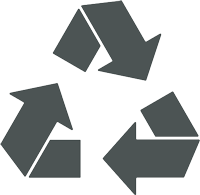The Sustainability Imperative
For all of humanity but particularly for business and industry, sustainability is no passing fad. It is what determines their long-term viability. People want safe, healthy, and energy-efficient living and working conditions. Businesses are building sustainability into their workflows and technologies – in their factory floors and offices, their supply chains and retail spaces, and even in their products and services.
With 70 percent of PVC resin going into the built environment, the vinyl industry is advancing sustainability performance across three impact categories where it can make significant contributions – resource efficiency, emissions, and health and safety.

Resource Efficiency
The vinyl industry is increasing its efforts to divert more landfilled material for repurpose, recycled feedstock, and reuse. Approximately 1.1 billion pounds of vinyl is recycled annually in the U.S. and Canada — this includes 87% pre-consumer vinyl materials and 13% post-consumer (non-packaging) vinyl materials. Since 2016, overall vinyl recycling has increased 7%. The majority of this increase is attributed to pre-consumer recycling; the percentage of post-consumer recycled material has remained flat during the same time period. Given the need to increase post-consumer vinyl recycling, we set an industry goal to increase post-consumer recycling to 160 million pounds by 2025.

Emissions
The vinyl industry is identifying emissions currently being tracked at all steps of the vinyl value chain; calculating a baseline and setting continuous improvement goals as needed; aggregating the data for reporting purposes to stakeholders, and recognizing the most sustainable practices to further mitigate emissions.


People & Community
The vinyl industry is identifying best practices in community efforts and setting targets for industry-wide adoption; encouraging use of environmental management systems, and ensuring the continued safe use of ingredients in our manufacturing processes and products.
